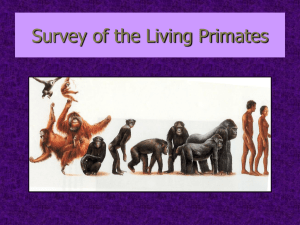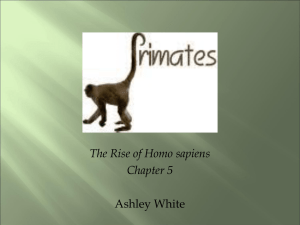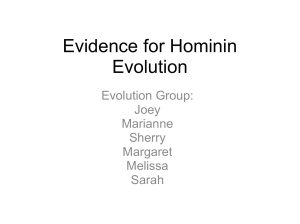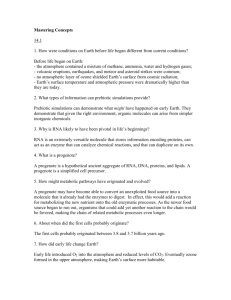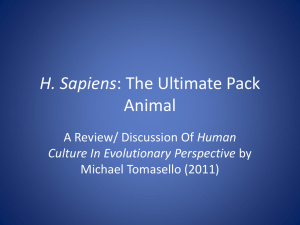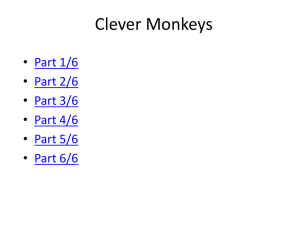terrestrial - Ouray School District R-1
advertisement
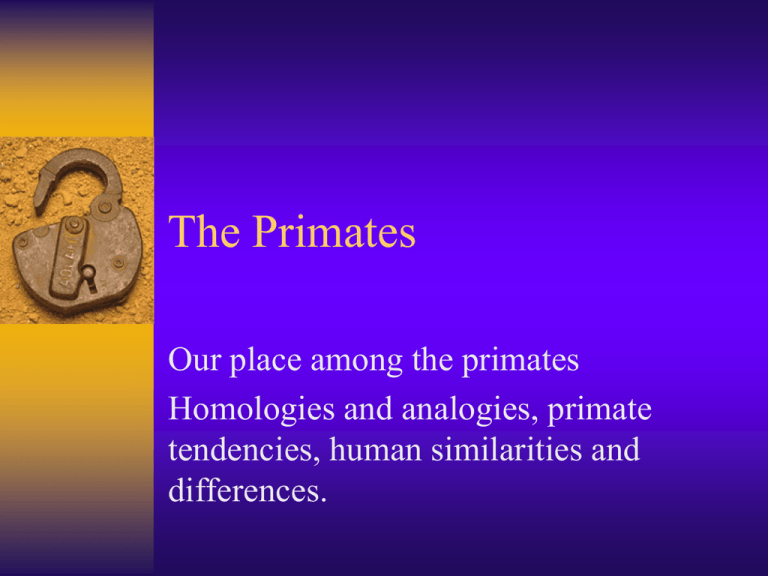
The Primates Our place among the primates Homologies and analogies, primate tendencies, human similarities and differences. Primatology Is the study of nonhuman primates-fossil and living apes, monkeys, and prosimians, including their behavior, and social life. Helps anthropologist to make inferences about early social organization of hominids (members of the zoological family that includes fossil and living humans to and to untangle issues of human nature and the origins of culture. Two kinds of primates 1. Those whose ecological adaptations are similar to our own: terrestrial monkeys and apes-primates that live on the ground rather than in trees. 2. Those that are most closely related to us: the great apes, specifically the chimpanzees and gorillas. Our place among Primates Similarities between humans and apes are evident in anatomy, brain structure, genetics, and biochemistry. Physical similarities are recognized through in zoological taxonomy-which is the assignment of organisms to categories according to their relationship and resemblance. Many similarities between organisms reflect their common phylogeny: which is their generic relatedness based on common ancestry. Humans and apes belong to the same taxonomic superfamily, Hominoidea (hominids). Monkeys are placed in 2 other families, which means we are more closely related to apes than either is to monkeys. Principal classification units of zoological taxonomy Kingdom Phylum Subphylum Class Infraclass Order Suborder Infraorder Superfamily Family Genus Species Subspecies Each lower level belongs to the higher level unit above it. Species: a group of organisms that can mate and give birth to viable(capable of living) and fertile-capable of reproducing offspring whose own offspring are viable and fertile. Classification continued Speciation: the formation of a new species occurs when groups that once belonged to the same species can no longer interbreed. After a sufficiently long period of reproductive isolation, two closely related species assigned to the same genus will have evolved out of one. The similarities used to assign organisms to the same taxon are called homologies, similarities they have jointly inherited from a common ancestor. (hand out table 4.1) Humans are mammals that belong to the order Primates. Homologies and Analogies The extensive biochemical homologies between apes and humans confirm our common ancestry and support our traditional joint classification as hominoids. It is estimated that chimps, humans, and gorillas have more than 98% of the DNA in common. Analogies: When similar traits arise if species experience similar selective forces and adapt them in similar ways. Convergent evolution:the process by which analogies are produced. EX. Fish and Porpoises. Table 4.2, our degree of relatedness to other primates. Primate Tendencies Primates are varied because they have adapted to diverse ecological niches. Many trends in primate evolution are best exemplified by the anthropoids:monkeys, apes, and humans which constitute the suborder Anthropoidea. The other primate suborder, Prosimii, includes lemurs, lorises, and tarsiers. These prosimians are more distant relatives of humans than are monkeys and apes. The primate trends –mostly developed in anthropoidsconstitute an anthropoid heritage that humans share with monkeys and apes. Primate Tendencies 1. Grasping: 5-digit feet and hands suited for grasping. Humans and many other primates have opposable thumbs: meaning they can touch other fingers. 2. Smell to Sight:Most important means to obtaining info. The portion of the brain devoted to vision expanded, while the area concerned with smell shrank. 3. Nose to hand:Main touch organ is the hand, specifically the sensitive pads of the “fingerprint” region. 4. Brain Complexity: The proportion of brain tissue concerned with memory, thought, and association has increased in primates. 5. Parental Investment: Most primates give birth to a single offspring rather than a litter; growing primates receive more attention and more learning opportunities. 6. Sociality: tend to be more social animals to help raise young. Prosimians The earliest history of the primates is limited to prosimian- like animals known through the fossil record, appeared more than 40 million years ago. Some managed to survive because the adapted to nocturnal life, which meant they did not compete with Anthropoids, which are active during the day. Examples: Lemurs: eat fruits, plant foods,eggs and insects. Tarsier: Confined to Indonesia and the Philippines. Lorises: Nocturnal prosimians found in Africa and Asia. Anthropoids All anthropoids have overlapping fields of vision, permitting them to see things in depth. Eyes are placed forward in the skull and look directly ahead. Depth perception because overlapping visual fields, which with color vision helped to distinguish edible insects, fruits, berries and leaves and makes it easier to groom. Grooming in one way of foming and maintaining social bonds. Manual dexterity, including the opposable thumb, is a tremendous advantage in examining and manipulating objects and is essential to a major human adaptive capacity: Tool Making A bigger brain enables monkeys, apes, and humans to store an array of visual images in their memories, which permits them to learn more. The ability to learn from experience and others is a major reason for the success of anthropoids compared to other mammals. Monkeys The anthropoid suborder has 2 infraorders: platyrrhines (New World monkeys) and catarrhines (Old World Monkeys, apes, and humans). The catarrhines (sharp-nosed) and platyrrhines (flat-nosed) are named for Latin terms that describe the placement of nostrils. (fig. 4.3) All old and new world monkeys are arboreal. Monkeys move different from apes and humans. Their arms and legs move parellel to one another as dogs do and are the same length, which contrasts to apes(when sitting) and humans who have orthograde posture, the straight and upright stance. Monkeys also have tails to help with balance in trees. New World Monkeys (NW) Live in the forest of Central and South America. Some parallels between some NW and OW. These are convergent evolution: has developed as a result of adaptation to a similar arboreal niche. EX: Brachiation: which is under-the-branch swinging. Most monkeys run and jump from branch to branch, but gibbons and some NW swing, using hands as hooks. Many NW have prehensile, grasping tails (Fig 4.4), which sometimes have has tactile skin that allows it to work like a hand in conveying food to mouth Old World Monkeys (OW) Specializations: rough patches of skin on buttocks, adapted to sit on hard rocky ground and rough branches. Both a terrestrial and arboreal species, with certain traits to differentiate. Arboreal tend to be smaller, which can reach a greater variety of food. Arboreal are also lithe and agile, they escape from predators though alertness and speed. Another contrast is sexual dimorphism (marked differences in male and female anatomy and temperament, which is more marked in terrestrial. Terrestrial Monkeys Example: Baboons of Africa and macaques in Asia. Terrestrial monkeys have specializations in anatomy, psychology, and social behavior that enable them to cope with terrestrial life. Male baboons are fierce-looking and can weigh up to 100 pounds. They display long projecting canines to intimidate predators. A male can also puff up his mane, so they can be perceived larger. At puberty male baboon and macaque leave their home troop for another, which makes females the stable core of the group. Terrestrial core= females. Among apes=males. Female chimps and gorillas are more likely to emigrate out of their group. Apes Humans and apes compose the hominoid superfamily Hominoidea. Great apes are orangutans, gorillas, and chimps. Smaller apes are the gibbons and siamangs of SE Asia and Indonesia. Humans could be included here too, called “the third African Ape” Apes live in forests and woodlands. Ape behavior and anatomy reveal past and present adaptation to arboreal life. Ex: Apes still build nests to sleep in trees, they have longer arms and legs adapted for brachiation(fig 4.5) The structural collar bone of apes and humans suggest that we had brachiate ancestor. The terrestrial locomotion of chimps and gorillas is called knucklewalking, where long arms and callused knuckles support the trunk as the apes amble around leaning forward. Gibbons Widespread in the forests of Southeast Asia (Malaysia). Are the smallest of the Apes(3ft, 12-25lbs) Spend most of their time just below forest canopy(treetops) Have long arms and fingers, with short thumbs for efficient brachiation. Most agile apes. Not knuckle-walkers, instead they use long arms for balance. Eat a fruit diet and tend to live in primary groups, which are composed of permanently bonded male and female and offspring. There are hundreds of thousands of gibbons that span a wide area of Southeast Asia. Orangutans Genus Pongo. Contemporary confined to two Indonesian islands. Marked sexual dimorphism, with adult male weighing as much as twice the female(may exceed 200 lbs). Middle in size between chimps and gorillas. More arboreal with their size, they typically climb, rather than swing, the trees. Varied diet of fruit, bark, leaves, and insects. Hard to study. Tend to be solitary animals. Tightest social units consist of females and young. Males forge alone. Gorillas One species Gorilla gorilla, with 3 subspecies. 1. Western lowland (zoos): smallest, lives in forest in Central African Republic, Congo, Cameroon, Gabon, Guinea, and Nigeria. 2. Eastern lowland: larger and lives in Congo(only 4 in captivity). 3. Mountain gorillas: (0 in captivity) Only 650 alive. Largest with long hair. Studied by Dianne Fossey. Full grown males weigh up to 400lbs and stand 6ft tall. Marked sexual dimorphism, females weigh half as much. Little time in trees, but if they sleep in trees their nests are no more than 10 feet off the ground. Gorillas continued Most of the day is spent feeding: move through forest undergrowth eating plants, leaves, bark, and fruits. Mainly large quantities of green bulk vegetation. Live in social groups. Troop is a common unit of primate social organization, consisting of multiple males, females and offspring. (mostly 10-20). Stable memberships with little group shifting. Each troop has a silverback male(white stripe of white hair that extends down back) who is usually the only breeding male in the group. “One-male groups” Chimpanzees Genus Pan, which has 2 species: Pan troglodytes (the common chimp) and Pan paniscus (the Bonobo or “pygmy” chimp). Similar to gorillas: live in Africa, but live over a large area and in more varied environments (Fig 4.6) Common chimps live mainly tropical rain forests, also in woodlands and mixed forest areas. Chimps prefer to eat fruit. They are omnivorous, eating small mammals, birds’ eggs, and insects. Lighter and more arboreal. Adult male is 100-200 lbs. Much less sexual dimorphism, females are about 88% of the average male height, which is similar to humans. Chimps continued Chimp communities regularly split up into smaller groups: a mother and offspring; a few males; males, females and young; solitary animals. Semiclosed communities. Social network of males is more closed than the females, which are more likely to migrate and mate outside their natal groups. Very vocal: greet one another with gestures, facial expressions, and calls. They hoot to maintain contact. Exhibit dominance relationships through attacks and displacement. Endangered Primates Deforestation poses a risk for primates because 90% of the 190 primate species live in tropical forests(Fig 4.7). All non-huaman primates are endangered. The apes (gibbons, gorillas, orangutans, and chimps) are in the “most endangered category. Habitat destruction and fragmentation can isolate small groups of animals, leaving them vulnerable to extinction due to loss of genetic diversity. Another threat is hunting of primates for bush meat, skins and pelts. Primates are also killed when they are agricultural pests. Primates are also captured for use in labs or as pets. Chimps have been used widely in biomedical research. Gorrilas in the Mist??? Human-Primate Similarities Learning: Monkeys, apes, and humans all learn throughout their lives. For all, the ability to learn, to profit from experience, confers a adaptive advantage, permitting them to void fatal mistakes. Tools:We first thought that humans were the only primates that made tools with a specific purpose in mind, but we have found that chimps also demonstrate this behavior. Ex: to get water from places their mouths can’t reach, chimps chew a leaf and then use like a “sponge”. Chimps also make tools to probe termite hills. Pick twigs and modify by removing leaves and bark to expose sticky surface beneath. When chimps are trained by humans, their skills flower. Wild chimps and orangs aim and throw objects. Hominids have elaborated the capacity to aim and throw= without this we would have never developed projectile technology and weaponry or baseball. Similarities continued Predation and Hunting: Chimps in a large community size permits the formation of a large hunting parties, which contributes to hunting success. Most hunts result in at least one prey being caught. Hunting by chimps is both opportunistic and planned.(103) Aggression and Resources: Jane Goodall specifically linked chimp agression and predation to human encroachment on their natural habitat. Gombe chimps are divided into Northern and Southern groups(smaller). Parties from the North have invaded the southern territory and killed. Infant victims were partially eaten. Also, Orangs have suffered due to human encroachment-farming and timbering. In Indonesia, in response to nearby human activities, organs have developed a pattern of extreme sexual antagonism. Primate behavior is not rigidly determined by genes. It is plastic(flexible). Among humans too, aggression increases when resources are scarce. Aggression and predation reflect environmental variation. Human-Primate Differences Sharing and Cooperation: Early humans lived in small social groups called bands, economies based on hunting and gathering. Men would hunt, women would gather. When they returned they would share. Elders were protected by the young, which would enable them to live longer and share knowledge and experience. The amount of info stored in a human band is far greater than that in any other primate society. Monkeys tend to fend for themselves. Among primates except Homo,most food comes from individual foraging. Mating and Kinship Differences Among baboons and chimps, most sexual intercourse tends to occur when females “go into heat” or enter estrus, a period of sexual receptivity-signaled by swelling of vaginal skin. Females form temporary bonds with males. Among humans, sexual activity occurs throughout the year. Because of more constant sexuality, all human societies have some form of marriage. Marriage gives mating a reliable basis and grants to each spouse special sexual rights to the other. Ties of affection and mutual support between members of different local groups tend to be absent among primates other than Homo. Primates tend to disperse at adolescence. Humans choose mates from outside the natal group, as well as monkeys, and usually at least one human spouse moves. Humans maintain lifelong ties with offspring, which is major contrast to other primates. Social Mobility and Fitness Socialbiology: studies the evolutionary basis of social behavior. Biological traits of contemporary organiams have been transmitted across the generations because those traits have enabled their ancestors to survive and reproduce more effectively than others. Members of the same species may compete to maximize their reproductive fitness-genetic contribution to future. Individual fitness: is measured by the number of direct descendants an individual has. Some monkeys kill the offspring of other males to clear a place for their own progeny. One’s genetic contribution to future can also be enhanced by cooperation, sharing and unselfish behavior. Inclusive fitness: reproductive success measured by the genes on shares with relatives. Ex: female might invest in sister’s offspring, or male risk his life to save brothers. Males will invest most in offspring when they are surest the offspring is theirs.
